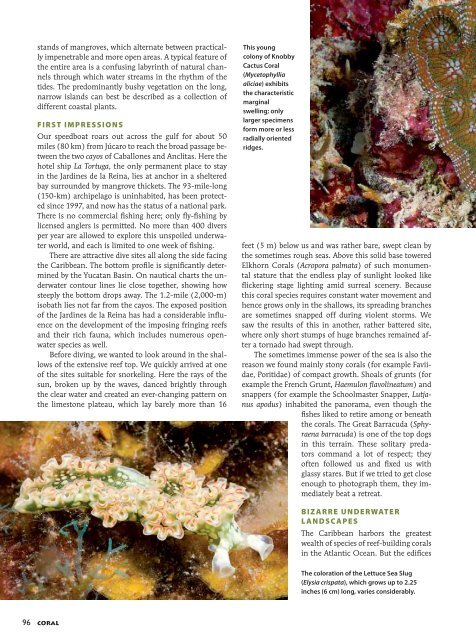Create successful ePaper yourself
Turn your PDF publications into a flip-book with our unique Google optimized e-Paper software.
stands of mangroves, which alternate between practically<br />
impenetrable and more open areas. A typical feature of<br />
the entire area is a confusing labyrinth of natural channels<br />
through which water streams in the rhythm of the<br />
tides. The predominantly bushy vegetation on the long,<br />
narrow islands can best be described as a collection of<br />
different coastal plants.<br />
FIRST IMPRESSIONS<br />
Our speedboat roars out across the gulf for about 50<br />
miles (80 km) from Júcaro to reach the broad passage between<br />
the two cayos of Caballones and Anclitas. Here the<br />
hotel ship La Tortuga, the only permanent place to stay<br />
in the Jardines de la Reina, lies at anchor in a sheltered<br />
bay surrounded by mangrove thickets. The 93-mile-long<br />
(150-km) archipelago is uninhabited, has been protected<br />
since 1997, and now has the status of a national park.<br />
There is no commercial fishing here; only fly-fishing by<br />
licensed anglers is permitted. No more than 400 divers<br />
per year are allowed to explore this unspoiled underwater<br />
world, and each is limited to one week of fishing.<br />
There are attractive dive sites all along the side facing<br />
the Caribbean. The bottom profile is significantly determined<br />
by the Yucatan Basin. On nautical charts the underwater<br />
contour lines lie close together, showing how<br />
steeply the bottom drops away. The 1.2-mile (2,000-m)<br />
isobath lies not far from the cayos. The exposed position<br />
of the Jardines de la Reina has had a considerable influence<br />
on the development of the imposing fringing reefs<br />
and their rich fauna, which includes numerous openwater<br />
species as well.<br />
Before diving, we wanted to look around in the shallows<br />
of the extensive reef top. We quickly arrived at one<br />
of the sites suitable for snorkeling. Here the rays of the<br />
sun, broken up by the waves, danced brightly through<br />
the clear water and created an ever-changing pattern on<br />
the limestone plateau, which lay barely more than 16<br />
This young<br />
colony of Knobby<br />
Cactus Coral<br />
(Mycetophyllia<br />
aliciae) exhibits<br />
the characteristic<br />
marginal<br />
swelling; only<br />
larger specimens<br />
form more or less<br />
radially oriented<br />
ridges.<br />
feet (5 m) below us and was rather bare, swept clean by<br />
the sometimes rough seas. Above this solid base towered<br />
Elkhorn Corals (Acropora palmata) of such monumental<br />
stature that the endless play of sunlight looked like<br />
flickering stage lighting amid surreal scenery. Because<br />
this coral species requires constant water movement and<br />
hence grows only in the shallows, its spreading branches<br />
are sometimes snapped off during violent storms. We<br />
saw the results of this in another, rather battered site,<br />
where only short stumps of huge branches remained after<br />
a tornado had swept through.<br />
The sometimes immense power of the sea is also the<br />
reason we found mainly stony corals (for example Faviidae,<br />
Poritidae) of compact growth. Shoals of grunts (for<br />
example the French Grunt, Haemulon flavolineatum) and<br />
snappers (for example the Schoolmaster Snapper, Lutjanus<br />
apodus) inhabited the panorama, even though the<br />
fishes liked to retire among or beneath<br />
the corals. The Great Barracuda (Sphyraena<br />
barracuda) is one of the top dogs<br />
in this terrain. These solitary predators<br />
command a lot of respect; they<br />
often followed us and fixed us with<br />
glassy stares. But if we tried to get close<br />
enough to photograph them, they immediately<br />
beat a retreat.<br />
BIZARRE UNDERWATER<br />
LANDSCAPES<br />
The Caribbean harbors the greatest<br />
wealth of species of reef-building corals<br />
in the Atlantic Ocean. But the edifices<br />
The coloration of the Lettuce Sea Slug<br />
(Elysia crispata), which grows up to 2.25<br />
inches (6 cm) long, varies considerably.<br />
96 CORAL

















